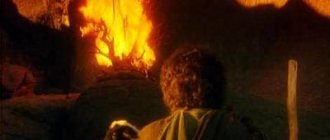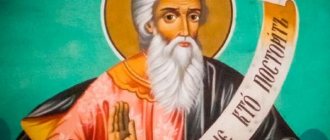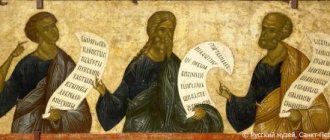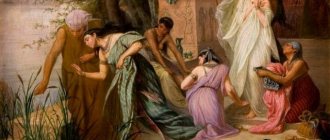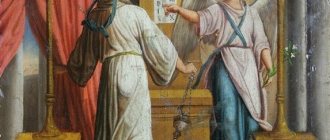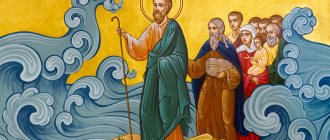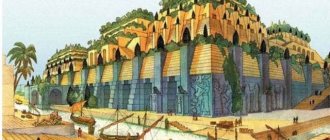The name Daniel means "God is my judge." Prophet Daniel (457-362 BC) is a character in the biblical Book of the Prophet Daniel (Old Testament). Coming from a noble Jewish family, he was taken captive in his youth by Nebuchadnezzar after the destruction of the Holy Temple in Jerusalem and served him at court until the conquest of Cyrus, remaining in his soul devoted to the God of Israel.
WHAT IS KNOWN FOR: successful interpretation of dreams, prophetic visions, interpretation of mysterious “writings on the wall”, and also for surviving in a ditch with hungry lions. It is believed that the prophet Daniel could predict the future. He was often visited by visions, including apocalyptic ones.
Most modern scholars believe that the prophet Daniel is not a genuine historical figure. To date, there is no evidence that such a person actually existed. Moreover, the realities described in the Book of the Prophet Daniel do not resemble the realities under Nebuchadnezzar. It is believed that the book was written much later - in the 2nd century BC.
In Judaism , Daniel is not considered a prophet, since he did not communicate with the Lord “directly,” but he is revered as an outstanding member of the Babylonian diaspora, unsurpassed in piety and good works, holding firmly to the law of God even when surrounded by enemies. The Christian Church recognizes Daniel as a prophet. Muslim sources recognize him as holy and righteous, although Daniel is not mentioned in the Koran.
INTERESTING FACT: Archangels Gabriel and Michael were first mentioned in the book of the prophet Daniel. Gabriel comes to the prophet Daniel in visions, and Michael is mentioned as a warrior archangel.
Dream interpretation
At the Babylonian court, the prophet received the Babylonian name - Balthasaurus. He was respected at the court of Nebuchadnezzar for his ability to interpret dreams. The most famous was his interpretation of Nebuchadnezzar's dream about a giant image made of 4 metals with legs made of iron and clay, destroyed by a stone flying from heaven.
Only Daniel managed to interpret the ruler’s dream: the dream meant four kingdoms, the first of which was Babylon. The Lord will destroy all kingdoms and establish the kingdom of heaven.
Daniel also interpreted Nebuchadnezzar's dream about a great tree that covered the whole world with its crown, and about a figure from heaven who destroys the tree. The Prophet interpreted the ruler's dream as follows: the power of the Lord is above the power of any rulers.
Daniel advised Nebuchadnezzar to engage in charity among the poor in order to be pleasing to the Lord. The king accepted this advice and helped the poor Jewish exiles in every possible way. Unfortunately, this did not last long. Soon the fear of the Lord passed, and Nebuchadnezzar abandoned the practice of donating to the poor from the royal treasury.
Prophet Daniel
Information about the Prophet Daniel
The Prophet Daniel (in Russian Daniil), who came from a noble family of the tribe of Yehuda, was a contemporary of Echezkel, who called him “wise.” When Jerusalem was destroyed by the hordes of Nebuchadnezzar, Daniel, along with other noble Jews, was taken to Babylon. Here he, along with three other young men - Michael, Azarya and Hananya, who, like Daniel, were distinguished by beauty, intelligence and good behavior, were prepared for three years to serve the king. Daniel was nicknamed Beltshazzar at court. Being at this time still a very young man, Daniel, however, very soon showed both strength of character and inflexibility in religious beliefs. He refused wine and dishes from the royal table and achieved that he was allowed to eat only vegetables, so as not to violate the rules of the Jewish religion. Out of love for Daniel, the chief of the courtiers agreed to this, despite the fact that this threatened him with punishment. Finally brought to the king, along with other comrades, Daniel made a strong impression on him with his intelligence and beauty and was left at court (Book of Daniel 1, 1-20).
Soon Daniel managed to distinguish himself thanks to his skillful interpretation of Nebuchadonossor's dream, which the rest of the Babylonian wise men and magicians could not do. As a reward for this, he became the person closest to the king and the chief over all the magicians and sorcerers of Babylon (Book of Daniel 2, 48).
Later, while already at the court of Belshazzar (Belshazzar), he alone was able to explain the mysterious inscription that was inscribed by an invisible hand on the wall of the palace where this king feasted with his entourage. For this interpretation, Daniel was richly endowed and appointed one of the three rulers of the Babylonian state (Book of Daniel 5, 11).
This title remained with him even after the death of Belshazzar, when the Babylonian throne passed to the Mede Darius. Being at the height of power, Daniel, however, does not abandon the Jewish religion, and now remains as faithful to it as in the first years of his stay at the Babylonian court.
The test of fear of God and religious inflexibility fell to his lot thanks to the machinations of the satraps and supreme leaders of the state, who were jealous of his glory and closeness to Darius. In an insidious way, they prompted Darius to issue a decree, according to which all subjects were commanded for three days not to make a request or prayer to any of the gods or people, but only to the king. Knowing that Daniel would not give up his faith in his God, they thus prepared his death.
Although Daniel was aware of this decree, he did not cease to pray as was his custom three times a day in his upper room, the windows of which were open towards Jerusalem. And when, as punishment for this, he was thrown into a pit among hungry lions, a miracle happened - the animals began to caress him and did not harm him. Believing in the power of the god Daniel, Darius orders that in all areas of his kingdom, everyone “should tremble and revere the god of Daniel, since He is God, living and ever-present... and delivers and saves and performs wonders and signs in heaven and on earth "(Book of Daniel 6, 1).
Share this page with your friends and family:
What's up
Writing on the wall - interpretation
Nebuchadnezzar died 397 BC. e. He was succeeded by his eldest son Amel-Marduk. Then Belshazzar came to power. When Belshazzar used sacred gold and silver vessels from the Jewish Holy Temple in Jerusalem during a feast, strange writings appeared on the wall, "mene mene tekel ufarsin" (literally "measured, measured, weighed and divided"). Despite the unprecedented riches that Belshazzar promised anyone who would explain the meaning of the message that appeared, none of the wise men could do this. On the advice of the queen, Daniel was summoned. Only the prophet Daniel was able to interpret the writings. He predicted to Belshazzar that the Persians would conquer his kingdom. And so it happened.
Rembrandt "Balthasar's Feast"
At the court of the new ruler Darius, the prophet Daniel also enjoyed authority, until one day ill-wishers informed the ruler that Daniel worshiped not him, but the Jewish God.
Daniel was thrown into the lions' den, but an angel saved him. Daniel continued to serve at the court of Darius. In the third year of Darius' reign, Daniel had a series of visions that are still widely interpreted today.
The last mention of Daniel occurs in the third year of the reign of Cyrus. According to non-canonical sources, the prophet Daniel was still living during the reign of Artaxerxes. There are at least five versions of where the body of the prophet Daniel rested. For example, Josephus wrote that Daniel's body was buried in a tower at Ecbatana in Parthia, next to the bodies of the Median and Persian kings. Muslim sources say that the body of the prophet rests in a secret place. The tomb in the city of Susa is the most likely burial option for the prophet Daniel.
Background [edit]
Muslim tradition has preserved some records of two figures named Daniel in the Hebrew Bible: the first is an ancient sage mentioned by Ezekiel[5], and the second is a seer who lived during the captivity in Babylon, whose life was recorded in the Book of Daniel, canonized in modern times. Hebrew Bible. The first figure is referred to in Muslim writing as "Daniel the Elder" and the second figure as Daniel. The character of Daniel in Muslim legend formed a figure similar to that of the prophet Idris, [6] as he is considered to have discovered the mysteries of the future along with a man who excelled in scientific matters. [7] However, other scholars reject this distinction and treat Daniel the Elder and Daniel as one and the same. [8] Also Ibn Tayimiya in his book “Al-Jawaab as Sahih” writes a lot about Daniel, who wrote and predicted Muhammad [9]
Bibliography[edit]
- Emil G. Hirsch and M. Seligson (1906), Daniel, Jewish Encyclopedia
;
quoting: Tabari, Chronigue
(French translation by Zotenberg), i. 44, 496, 503, 571, II. 283; - Mas'udi, Les Prairies d'Or
(ed. B. de Meinard), II. 128; - Barthélemy d'Herbelot, Bibliothèque Orientale
, s.v.
, II, 156 f. / 144; 165/150 sq.; III, 114 f. / 118 f. and index avg.
,
198–202.
Recommendations
- ^ a b
Noegel & Wheeler 2002, p. 74. - Redditt 2008, pp. 181-82.
- ^ a b c d
Collins 1999, p. 219. - ^ a b c
Gottheil & König 1906. - ^ a b
Noegel & Wheeler 2002, p. 76. - ^ a b
Ginsberg 1998, p. 326. - Redditt 2008, p. 180.
- ^ a b
Seow 2003, p. 4. - Jump up
↑ Walton 1994, p. 49. - Seow 2003, pp. 3-4.
- ^ a b
Collins 1999, p. 220. - Holman Bible Editorial, Holman Concise Bible Dictionary
, B&H Publishing Group, USA, 2011, page 153 - Wesselius 2002, p. 294.
- Jump up
↑ Collins 1984, pp. 34–35. - Jump up
↑ Collins 1984, pp. 29–30. - ^ a b
Spencer 2002, p. 90. - ^ a b
Noegel & Wheeler 2002, p. 75. - Jump up
↑ Ginzberg 1998, p. 350. - Jump up ↑
Stone 2011, p. 68. - Jump up
↑ Ginzberg 1998, p. 334. - Jump up
↑ Ginzberg 1998, p. 339. - Jump up
↑ Ginzberg 1998, p. 347. - "The Departure of the Great Prophet Daniel". Copticchurch.net. Retrieved June 30, 2012.
- Sergei Bulgakov, Guide for Church Ministers
, 2nd ed. (Kharkov, 1900) pp. 453–65. December 11–17: Sunday of the Holy Fathers Translation: Archpriest Eugene D. Tarris - Bulgakov, Guide for the Church of Servers
, pp. 461-62. December 18–24: Sunday before the Nativity of the Holy Fathers. - Francis E. Gigot (1889). "Daniel." Catholic Encyclopedia on CD
. New coming. - “Today in history is December 17th.” Chi.lcms.org. Retrieved June 30, 2012.
- Abdullah Yusuf Ali | The Holy Qur'an: Text, Translation and Commentary
,
Note.
150 - Al-Kulaini, Abu Jafar Muhammad ibn Yaqub (2015). Kitab al-Kafi
. South Huntington, New York: Islamic Seminary Inc. ISBN. 9780991430864. - Jump up ↑
May, Dann J (December 1993). The Baha'i principle of religious unity and the problem of radical pluralism. University of North Texas, Denton, Texas. paragraph 102. - From the East and West of Iran
. vol. 2, pp. 127, 106. Huang R.I. Cole, Mujan Momen. 1984
Literature[ | ]
- Archimandrite Theodore (Bukharev). Holy Prophet Daniel. Essay on his century, prophetic ministry and St. books. M. 1864.
- In the book of the holy prophet Daniel. Add. to creativity Holy Father. 1871.1 −146 s
- John (Smirnov). Holy Prophet Daniel. Ryazan, 1879.
- Lesotsky. Holy Prophet Daniel. Kyiv. 1897
- Razumovsky. Holy Prophet Daniel. St. Petersburg 1891.
- A. Rozhdestvensky. Revelation to Daniel about the seventy weeks. St. Petersburg 1896
- The life of the holy prophet Daniel and with him the three holy youths Ananias, Azariah and Misail // Lives of the saints in Russian, set out according to the guidance of the Chetyih-Menya of St. Demetrius of Rostov: 12 books, 2 books. add. - M.: Moscow. Synod. typ., 1903-1916. — Vol. IV: December, Day 17.
- P. Yungerov. A private historical-critical introduction to the sacred Old Testament books. Vol. second. pp. 87-110. Kazan. 1907.
- Weinberg J.
Introduction to Tanakh.
Part 4. Scriptures. M.-Jerusalem, 2005. Chapter X. Book of Daniel. P.219-251. (in notes: Weinberg 2005
) - Shchedrovitsky D.V. Prophecies of the Book of Daniel. 597 BC e. - 2240 AD e. / Ed. 3rd, ster.— M.: Oklik, 2010.— 280 pp.— ISBN 978-5-91349-003-2.
- Hamd ibn Nasir ibn Usman Al Muammar.
Refutation to grave worshipers = النبذة الشريفة النفيسة في الرد على القبوريين / Abdussalam ibn Barjis Al Abd al-Karim. - Riyadh: Dar al-Asima, 1988. - 182 p.
Notes
- Historical Dictionary of Prophets in Islam and Judaism
, BM Wheeler,
Daniel
: “Daniel is not mentioned by name in the Qur'an but there are accounts of his prophethood in later Muslim literature...” - Ephraim the Syrian, St.
Creations. T.6. Reprint edition. - M.: Publishing house “Father's House”, 1995. // Creations like those among the saints of our Father Ephraim the Syrian. Spiritual and moral scriptures. — Sergiev Posad. Printing house St.-Tr. Sergius Lavra, 1901, p. 51-89. - John Chrysostom, St.
Complete collection of the works of St. John Chrysostom in twelve volumes, vol. 6, Book two. - M.: St. John the Chrysostom publishing house, 2000, chapter 2. - Hamd Al Muammar, 1988, p. 130.
Tomb of St. Daniel in Samarkand
The Mausoleum of Khoja Daniyar (Prophet Daniel, as Christians call him, the Great Jewish Prophet - Jews) is a revered shrine. The tomb is located in Samarkand. The spirit of the Great Prophet patronizes, protects and brings prosperity. At the foot of the Mausoleum there flows a healing spring with healing properties; pilgrims, tourists and foreigners walk along the path to it. The Siab River flows nearby, swans fly in in the summer, peace, polyphonic foreign speech can be heard from everywhere.
The mausoleum was built at the beginning of the last century by soap makers of Samarkand in the form of a rectangular building with 6 domes. Initially, the burial place of the Prophet was covered with river stones, and was subsequently rebuilt and completed. The tomb of the prophet Daniel is amazing in size – it stretches 20 meters along the wall. The dakhma (funeral structure) in which the holy prophet is buried is covered with green velvet and with Arabic script embroidered with gold threads. The bedspreads are changed periodically. There are several explanations for such a long tombstone: someone assures that this was done on purpose so that ill-wishers and enemies could not find the holy relics of the Prophet. The ministers say that this is the hand of the Saint growing: when it clasps the globe, heaven will come on earth.


